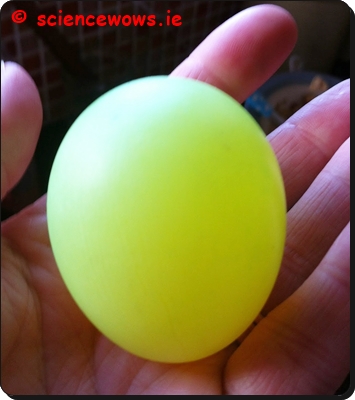With all the excitement of the Easter bunny we forgot about our last egg- experiment…”the bouncy egg” so I thought it might be a fun one to start off this new blog spot… “Fun Friday”, where I will share a new experiment for you to try!
So firstly, this is how we set up the experiment….
We left the eggs in the vinegar for two days and then removed them and gently washed them in a bowl of water … unfortunately, when I was washing the egg from the plain vinegar experiment, I burst it… Ooops!
No harm done as we substituted the other just to show you how the “bouncy” bit worked!
The result…(we had a very cautious scientist in the video but you can get quite a bounce out of the egg!)
What has happened to the shell?
The vinegar is an acid (acetic acid); it reacts with the calcium in the egg shell (calcium carbonate) and breaks it down, producing a gas as it does so. You may have observed the gas as bubbles being formed, during the experiment. Effectively the vinegar (acid) eats away at the egg shell until it is all gone.
The fluorescent bit
Then for a bit more fun I turned on a UV light! Ok, I know, most of you don’t have one of these lying around at home but as I’m a Mad Scientist I do ;0) …and I was curious to know what would happen if we left it sit in fluorescent vinegar.
The results were Fab!! A fluorescent egg… check it out! (I hope you can hear me in the video, sound is a bit low!)
So there you go, it worked better than I expected… the egg is completely fluorescent…. and bouncy, just for that extra bit of fun!
What is fluorescence?
In case you are wondering “WHAT IS FLUORESCENCE?”….let me explain… it is the emission of light from an object after it has absorbed light (or electromagnetic energy)…. usually the light absorbed has a short wavelength (in this case the UV light) and the light emitted has a longer wavelength.
When I shone the UV light onto the egg it “glowed”, even in daylight it looks bright – just like a fluorescent pen!
